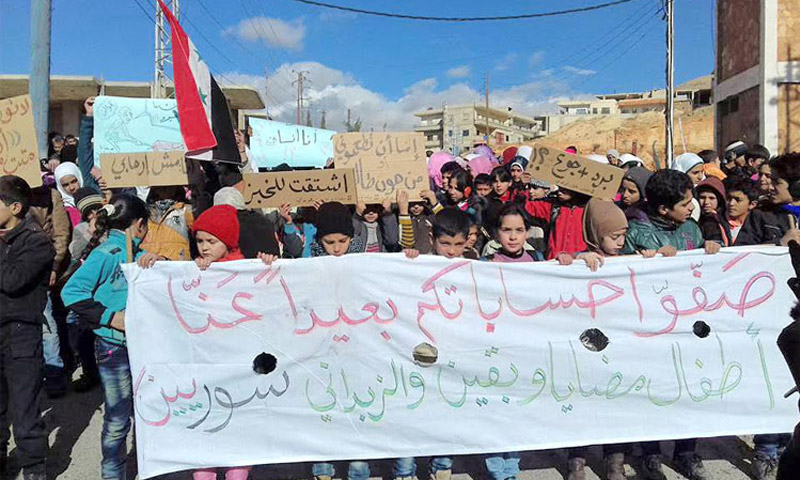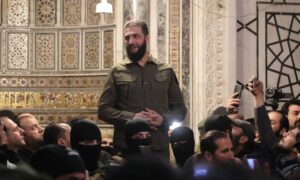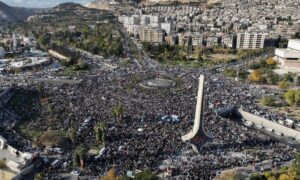Enab Baladi
The most recent talks in Vienna declared a gradual ceasefire in Syria. It additionally provided items to reach a political solution at the end of which presidential elections will be held in Syria. These declarations were made in spite of the great obstacles that lie ahead, the indecisiveness of the International Community over Assad’s fate, and the Syrian armed opposition and political doubting of the success of the decision taken. In light of these issues, it is important to discuss the armistices, reconciliations, truces, and settlements between Assad regime and opposition over the course of the past four years.
This report does not offer statistics of the settlements between Assad regime and opposition. It sheds light on some of the models implemented in Damascus and Damascus countryside. We especially choose these because of the significance of the capital which Assad succeeded to neutralize militarily although the opposition fighters surround the capital.
Recently, there were a lot of talks about a possible ceasefire in Eastern and Western Ghouta, but there was no mention of the procedures and terms on how to implement the cease. However, there are doubts that the cease will be successful as Assad continues to target Ghouta and the capital.
In contrast, it seems that a comprehensive solution is taking place in besieged al-Wair district in the city of Homs. An agreement between opposition delegates and representatives of the regime was reached few days ago. Medication and food were allowed in the district in exchange for opposition fighters leaving to Idlib Province. The opposition armed factions in the district denied this foggy agreement. Would al-Wair yield to Assad’s control or would it still be an opposition zone?
In the following, we provide an overview of a number of settlements which took place over the course of two years. Some settlements succeeded whereas some failed.
Armistices in Opposition stronghold, Homs
Syrian opposition fighters evacuated the old districts in Homs and headed to the “liberated” areas in Idlib Province on the 7th of May 2014.
The armed opposition factions Ahrar Ash-Sham (Islamic Movement of the Free Men of the Levant), al-Nusra front and Free Syrian Army were besieged in Homs for two years. They remained in the city with hundreds of families who preferred remaining over migrating in spite of destroyed public services and buildings. Assad’s recapture of Homs was facilitated with Iranian patronage and International Community supervision.
The agreement states that opposition fighters and remaining families evacuate to ed-Dar al-Kabira town in Idlib countryside. They can leave carrying their individual weapons and an amount of money which does not exceed 100 thousand Syrian pound. In exchange, al-Wair district will not be targeted and humanitarian corridors will open.
After fulfilling the agreement’s rules, negotiations of a possible truce will take place. In return, the opposition fighters will release tens of captives from Assad forces and pro-Assad militias and release of an Iranian captive. Also, humanitarian corridors will open to reach Nubul and Zahra; pro-regime towns in the north of Aleppo.
2400 civilians and fighters evacuated Homs rebellious districts and those are: al-Khalediye, Bab Siba’, Bab Hood, Ghuret al-Shiyah, al-Qusoor. The aforementioned districts have become ruins and Assad still refuses to rebuild and to allow the return of displaced families to their areas. The agreement was held with patronage of a senior Iranian official, major-general Muhammad Deeb Zeituon chairman of Political Security Branch, minister of civil reconciliation and governor of Homs.
Failed Armistices in Hama
Al-Madiq
The armistice in the town of al-Madiq in the north western countryside in Hama Province is the oldest. It offered a unique model contingent on power balance between Assad regime and opposition inside the town adjacent to al-Ghab Plain.
The ancient citadel is located in the middle of the town. It is the only part of the town under Assad’s control whereas the rest of the town is under the control of Free Syrian Army. The Free Syrian Army runs the town. There is a concealed agreement between Free Syrian Army and regime forces. The Free Syrian Army permits regime cars to enter the citadel and in return Assad forces deployed in the citadel do not target civilians.
This unique model is functioning until this point; however, Assad forces breached the armistice a few times. The most recent was last August, Assad air force raids targeted the town and killed13 civilians. Despite the breaches, the town is still relatively secure especially when we compare it to neighbouring villages and towns in al-Ghab Plain, which most of its population are displaced.
Nonetheless, the armistice in al-Madiq may collapse for a number of reasons. First, the battles, which erupted 6 months ago, continue in al-Ghab Plain. Second, the clashes taking place in the neighboring town Kafr Nabudah. Third, the faction Suqour al-Ghab (Falcons of al-Ghab) in Jaysh al-Nasr (the Army of Victory) is the most prominent Free Syrian Army factions in Hama. It was established from al-Madiq town fighters and dissident officers. Furthermore, Ahrar Ash-Sham Leader Muhanad al-Masri is from the town.
Kafr Nabudah
Kafr Nabudah armistices is completely different from the one in al-Madiq. It started in August 2014. The battles in Kafr Nabudah lasted a year and a half. Some part of the town got rebuilt and remains of destruction were cleared off streets.
The return of the town’s displaced population was contingent to it not becoming a military center and the end of military operations from opposition fighters and that’s what happened. Assad stopped targeting it completely and for 14 months, the city preserved stability. The population of Kafr Nabudah reached 50 thousand including migrants from other neighboring places.
Again, Assad forces breached the truce last October. Assad forces gave the population two choices. The first one is to permit Assad forces to make a passage of the city for military convoys heading towards Idlib southern countryside. The second is to destroy the city with varied ways of shelling. The result was erupting battles again and population migrating.
Assad forces tried to recapture the town, but they completely failed. It is still under the control of Free Syrian Army,
but the residents have migrated as a result of the battles.
Idlib-Zabadani Armistices
A truce was signed last September. The truce declares ceasefire and opening humanitarian corridors to the following towns: Madaya, Bikin, and Zabadani. In return, implement ceasefire and open humanitarian corridors in city of Idlib and other neighboring villages like pro-regime villages Kafraya and Fu’a.
The battles continued for three months on the outskirts of Zabadani and the Assad forces, Hezbollah and pro-regime militias could not fully recapture the city. The opposition fighters in the city are mostly from Ahrar Ash-Sham movement.
This agreement was under the patronage of Tehran and Ankara. It was signed in Istanbul. Delegates from Jaysh al-Fateh (Army of Conquest) participated in meeting.
The agreement seemed like a real solution to the towns in the south and the north included in the agreement; however, obstacles started appearing with the Russian intervention in Syria. Towns like Bikin and Madaya are still under complete besiege except for united nations aids coming in on 18th of October and the aids packages which United Nations distributed were expired and caused 200 cases of poisonous of civilians in Madaya because the biscuits they ate were expired. There are calls for intervention in both towns before a human catastrophe happens at a time when Hezbollah continues to bulldoze agricultural land and fruitful trees on the Zabadani plains.
The items of the armistice include ceasefire in Zabadani, Madaya, Bikin, Sarghaya, and surrounding military sections in Damascus countryside. Also, ceasefire includes Fu’a, Kafraya, Binish, Taftanaz, Ta’um, Masrin, Idlib city, Ram Hamdan, Zaradna and Shelekh in Idlib Province. The ceasefire is effective for six months during which opposition fighters evacuate and leave to Idlib. Families who want to leave can also leave to Idlib.
Ceasefire is the only item in the armistice which was fulfilled. Once more, it was breached many times in Idlib Province by Assad forces to which Jaysh al-Fateh responded by targeting Kafraya and Fu’a (pro-regime towns in Idlib Province).
Armistices in Damascus
Assad regime focuses its efforts on suppressing rebellious areas inside and outside the capital Damascus. Syrian regime started a series of agreements and truces which included cities and towns in the west and south of Damascus and included districts inside Damascus itself.
Northern Districts
These include Barzeh, Qabun, and Tishreen. These districts are under the control of armed opposition in the north of the capital. A truce was reached starting in Barzeh in February 2014.
Observers and activists consider the truce in Barzeh the most stable in Damascus governorate in spite of the small breaches committed by Assad forces. Most prominent of which is closing the main entrance to the district repetitively and detaining young men on military checkpoints around the entrance. Also, some cases of killing by the snippers.
The truce in Barzeh came following violent battles between opposition fighters and Assad forces. Although Assad used all types of land and air weapons, he could not advance in the district. Then the regime sought “the reconciliation”. The reconciliation includes
- Ceasefire
- Assad forces withdrawal from all Barzeh.
- Releasing the detainees in the regime prisons
- Facilitating public services and reforming infrastructure
- Opening main roads and permit the return of people after reforming the services.
Free Syrian army runs the area fully without surrendering any of its fighters or weapons.
A similar truce took place in Qabun and Tishreen districts in September 2014. Consequently, the southern front of the capital turned calm except for few breaches committed by regime forces. The recent one was artillery shelling and caused a number of casualties in Qabun.
South of Damascus
Towns of Bayt Sahm, Yalda and Babyla signed an open truce with Assad forces in February 2014. The truce is in place until this point.
Truces’ items:
- Free Syrian Army surrendering its heavy weapons.
- Free Syrian Army fighters can either stay in their areas or settle their matters with the regime.
- Deploying mutual checkpoints on outskirts of towns.
- Cease fire.
- Regime commits to open roads and entering aids to these towns and withdrawal of troops on the outskirts.
Another truce was signed in Qadam and ‘Assali districts with opposition forces in May 2014. Except for the regime did not demand withdrawal of heavy weapons from opposition fighters and opposition demanded regime stops destruction operations with the regime started since the outbreak of the revolution.
As a result of the aforementioned agreements and truces, southern Damascus became very secure for the Assad regime. Nonetheless, there are places in which no truce or agreement was reached and the battles continue there. For instance, in al-Tadamun district, there are still clashes between local fighters and Assad forces. Also, al-Hajar al-Eswad is under the control of Islamic state since 2014. Moreover, al-Yarmouk camp also witnessed fights between Islamic state and al-Nusra Front on one side, and on the other some Palestinian factions.
Western Ghouta
The truces in western Ghouta started on 25th December 2013 in Moadamiyeh, neighbor city of Daraya. According to activists, the agreement states on withdrawal of heavy weaponry and submit it to regime in exchange for stopping military operations and opening a humanitarian corridor in addition to releasing detainees from regime prisons and explain the situation of the missing. The regime did not fulfill this in the agreement in spite of repeated promises. The regime only gave corpses of young men who died from torture in prisons.
However, the truce in Moadamiyeh was breached many times by Assad forces which closed the eastern crossing which connects the city to Damascus. As a consequence, Moadamiyeh suffered from a severe siege. Moreover, the city was targeted many times by shells and missiles and barrels in spite of the agreed truce under pretexts. Most prominent of which is closing the western gate which connect Moadamiyeh to Daraya. Daraya which refused many propositions of truce and still fighting regime forces until this point.
Qudsaya
The regime demanded that 135 local fighters from Qudsaya evacuated and left towards Idlib accompanied by their families. Also, they were accompanied by Syria Red Crescent and reconciliation committee in the city on 30th of November. In return, the regime reopened the roads and lifted the siege imposed on the city.
Pro-regime Watan Newspaper published the agreement’s text. The Most prominent regulation in the armistice is “army and security forces cannot enter the city unless on individual basis and unarmed and their purpose for entrance is either to check their houses or visit family and relatives.” In exchange, people in Qudsaya pledge to stop the kidnapping operations and transfer the mission of security to a committee formed of people in Qudsaya. This committee is the only party who can be armed and deploy checkpoints inside the city.
The armistice was under the patronage of a reconciliation committee and Damascus Governorate Mufti Muhammed Adnan al-Afyoni. The armistice will expand to include al-Hameh town and if fighters in al-Hameh agree to the sections proposed, the regime will open Qudsaya-Damascus road. The road has been close for 6 months.
Activists confirmed the regime is trying to implement the same armistice and settlements in towns in Wadi Barada. These include: Basime, Ayn al-Fijeh, Wadi Muqren, Kifayr al-Zeet. The regime plan is to have a secure area starting from Zabadani to Madaya and reaches the capital. That way the Assad regime will guarantee security and military stability after domesticating the area between Qalamoon and Damascus.
A lot of Syrians consider the armistices as dodges since the regime continues to target and besiege civilians using all types of weapons and war machinery and at the same time works on establishing armistices in opposition areas. When, in fact, the regime’s objective is to put an end to the Syrian revolution.
Some Syrians consider the armistices a deliverance from the war and the material and psychological loss citizens have suffered over the course of four years. The international community has turned a blind eye on all the violations committed by Assad regime and which activists accused of conspiring with the regime to keep it in power even with all the blood spilled in Syria.
if you think the article contain wrong information or you have additional details Send Correction
-
Follow us :


















 A
A
A
A
A
A









 More In-Depth
More In-Depth